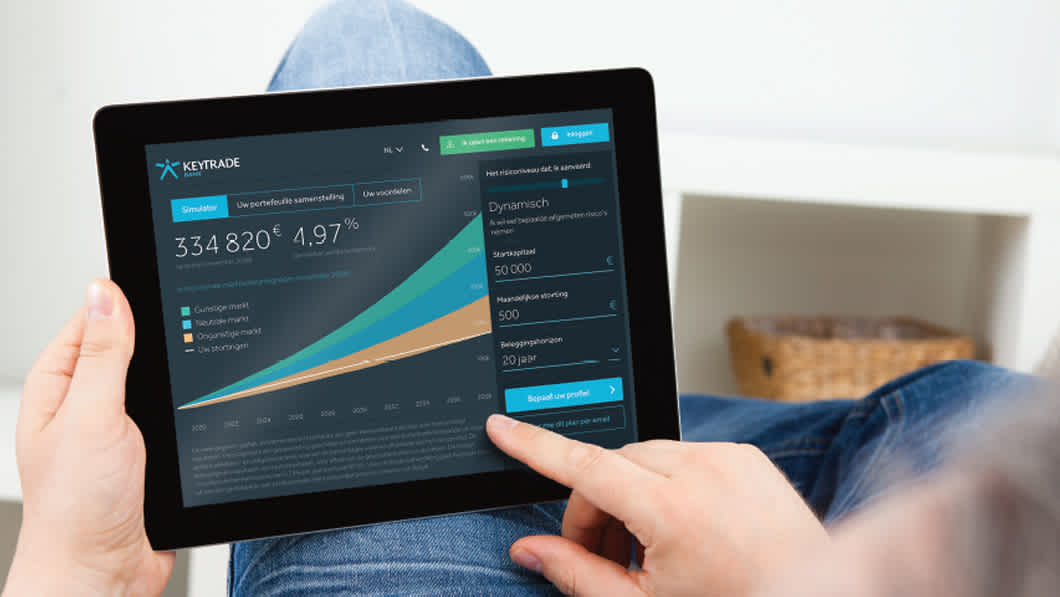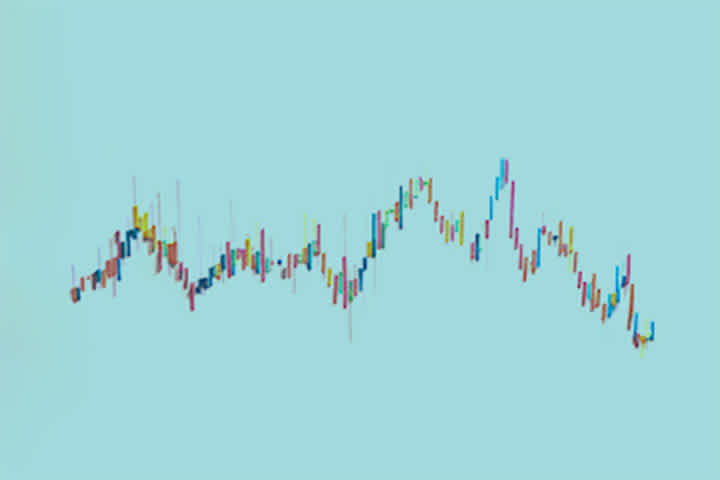Lump-sum investing vs cost averaging: which offers the highest return?
Keytrade Bank
keytradebank.be
December 13, 2024
3 minutes to read
Spread, spread and spread again. As an investor, this is the mantra that is hammered into you. Spread across equities and bonds. Spread across different regions. Spread across different sectors and themes. And of course spread over time.
Not putting all your eggs in one basket certainly has its benefits. Diversification helps to reduce the risks inherent in investing. If you invest all your money in a handful of shares or a single region or sector, you may end up sustaining severe financial losses if that corner of the stock market is in turmoil. If you spread your money across a hundred different shares in different regions, sectors and themes, your investment portfolio will be more resilient to shocks.
But what about spreading over time? This also seems to be a logical and smart move. The reasoning is simple: by splitting your investment into multiple smaller amounts and investing them over months or years, you reduce the risk of entering the market when it reaches its peak. Sometimes you buy shares when they are expensive and sometimes when they are cheap. Spreading your investment over time helps to level out the average purchase price of your investments. And it gives you more peace of mind. But what does spreading your investment over time mean for your return?
Everything all at once or spread it out?
For example: Tim and Isabel are both 32 years old. They want to go on a round-the-world trip together when they are 40. Their idea is to invest rather than save money to maximise their budget. They believe this will yield a higher potential return in the long term.
Let's assume they each have 20,000 euros to invest today and they want to give their investments eight years to grow. Tim and Isabel invest in exactly the same tracker (ETF) on the MSCI World. The MSCI World is an index that tracks the performance of more than 1,400 large and mid-cap stocks in 23 countries. By choosing this tracker, Tim and Isabel think they have already spread their investment nicely: an indirect investment in 1,400 different shares is sufficient for them. Isabel invests the full amount of 20,000 euros at once. She believes this will allow her to benefit directly from the market's long-term growth and possible price increases.
Tim, however, decides to spread the risk of poorly timed investments. He divides his 20,000 euros into four parts and invests 5,000 euros every two years, regardless of whether the market is up or down at the time. He starts today with 5,000 euros. He will invest another 5,000 euros in two years, another in four years and another in six years.
Who will be the winner?
Let's say the index generates an average return of 6% per year. Even though this is less than the historical average of 8.54%, it is still a great result. How much have their investments grown by?
After eight years, Isabel has 31,876.96 euros, while Tim has 26,992.22 euros. Although they both invested 20,000 euros, Isabel now has 4,884.74 euros more in her travel budget.
This is because Isabel invested her entire amount at the start and started to build a return on the entire amount over the full eight years. Tim spread his investment, which meant some of his money didn't generate the average 6% return for quite some time.
This example shows that if you invest in the long term, it may be more advantageous to invest your money straight away rather than spread it out over time.
What do the figures say about the best approach?
Okay, you think, but that was just a hypothetical example. So let's take a look at a Vanguard study that confirms these results are not purely theoretical. Based on an analysis of the MSCI World index between 1976 and 2022, Vanguard discovered that over a period of just one year, lump-sum investments yielded a higher return than spread investments in 68% of cases. So even if you invest in the short term, you are more likely to achieve a higher return if you invest everything at once. This probability will only increase in the long term. Based on past performance (1926–2022), there is a one in four probability of losing money if you invest for one year. However, if you were to invest for 10 years, that probability falls to around one in 25, and after 20 years it even falls to zero. A lump-sum investment can yield a higher potential return because markets tend to follow an upward trend in the longer term. It also means your entire amount immediately benefits from potential market increases along with a compounding effect (when you reinvest your dividends, for example).
So what does make drip feeding attractive?
So does this make drip feeding a 'bad' choice? Not at all.
Not every investor has 20,000 euros in savings available. Drip feeding also offers benefits in terms of risk management and peace of mind. It reduces the stress of finding the “perfect entry point” and protects short-term investors from the impact of short-term declines or volatility just after making a large investment. If investors worry about market fluctuations or entering a down market, drip feeding can help them to stay invested in the long term. And that is crucial to actually benefit from an upward trend in the market. Investing – either with a lump sum or by drip feeding – is better than not investing at all. In short, your choice of strategy – a lump-sum investment, drip feeding or a combination of both – depends on your financial situation, your risk tolerance and your feelings about market fluctuations. Historically, investing a lump sum offers the best chance of a higher return. Cost averaging is a more controlled approach with fewer worries about ensuring the right entry point.
Other articles that might interest you
![iPad]()
Monthly video 2025
![GraphOfTheWeek]()
Defensive shares as a buffer?
![GraphOfTheWeek]()
US shares no longer number one!
![blogHeader-renov]()
Investing in your partner’s home? Don’t make these mistakes!
![blogHeader-GeldLenen]()
Lending money to family or friends: do you have carte blanche?
![iPad]()
Monthly video 2024
![blogHeader-Trap]()
What you need to know before you start dividend investing
![blog-ouderKoppel]()
40 years of pension savings: what will you spend it on (literally)?
![blog-AstroMars]()
From FOMO to ZERO bank account? 5x pension savings to the rescue
![pension pilars]()
Start growing your pension sooner rather than later
![blogHeader-bestchoicesP]()
Pension savings returns: these choices give the maximum payout
![blogHeader-VrouwenPensi]()
Why pension planning is even more important for women
![blogHeader-americaFirst]()
United States 1, Everyone Else 0
![Newspaper with ETF's circled in red, a red pen and a magnifying glass on top]()
What is a tracker and how do you choose the right one?
![blogHeader-TypeBeleger]()
What type of investor are you? Take the quiz
![blog-EpargeEnfant]()
How can you teach your child to save? 12 tips
![GraphOfTheWeek]()
A potential worldwide trade war is claiming European victims
![blogHeader-animals]()
Ever thought of investing in the pet industry?
![GraphOfTheWeek]()
Have long-term interest rates once again started a 40-year uptrend?
![GraphOfTheWeek]()
Graph of the Week: Magnificent 7 vs 2000s Tech Bubble
![blog-volatility]()
5 mistakes investors make in volatile markets
![termijnrekening]()
Government bonds, savings accounts, or term accounts: which should you choose?
![house-flipping 330509387]()
House flipping: is it worthwhile?
![vix 1827107540]()
Investing in dividend shares: what to look for?
![blog-dividentenRe]()
Why high dividend yields can be a poisoned chalice
![blogHeader-WeinigTijd]()
3 ways to invest when you don't have much time.
![blogHeader-fondsKiezen]()
How do you select an investment fund for your child?
![blogHeader-SparenVoorKi]()
How can I invest or save better for my child?
![blogHeader-Robotica]()
Robotics: From science fiction to science
![blogHeader-Vastgoedaand]()
Property shares: ripe for a comeback?
![coronablog 1670847745]()
Coronablog by Geert Van Herck: Market Observations
![blogHeader-HogereRendem]()
Is it the right time to invest in bonds?
![blogHeader-PeriodiekBel]()
Have you ever thought about investing for your children?
![blog-tweedeLening]()
Borrowing for a second home: what are your options?
![Blog-VoyageMars]()
How can you invest in space travel?
![blogHeader-ZelfOfLaten]()
Invest yourself or have someone do it for you: do you have to choose?
![tell-tax-man 1044303100]()
What do you have to tell the tax man about your money and investments?
![iPad]()
Monthly video 2023
![myth-sustainable 1059639044]()
Five myths about sustainable investing
![Blog-Viellissement]()
How can you invest in an ageing population?
![panneaux solaires]()
6 reasons why installing solar panels is still worthwhile in 2024
![Blog-Vote]()
How do elections affect the stock market?
![Picture article gold]()
Golden days? Why to invest in gold (or not)
![blog-aLouer-TeHuu]()
Is a buy-to-let property a smart investment?
![emerging markets 2]()
Investing in emerging markets: are investment funds a smarter buy than trackers?
![Watch out, danger's about]()
Watch out, danger's about
![blog-DigitalHerit]()
Will AI replace human investment advisers?
![blog energyInvestment]()
How to invest in the energy transition?
![inde2]()
Is India the new China?
Which sectors should remain overweight following the latest rate hike?
![8 tijdloze regels]()
8 timeless rules for investors
![blog-savingForSak]()
Saving for the sake of saving? Or with a goal in mind?
![blog-PrepareYours]()
How do you prepare financially for a longer life?
![Investors, keep your emotions in check!]()
Investors, keep your emotions in check!
![How natural disasters affect the economy and the markets]()
How natural disasters affect the economy and the markets
![myth-sustainable 1059639044]()
Make an impact with your Keyprivate
![diversification]()
How much diversification is enough for your portfolio?
![intelligent mobility]()
Which investment opportunities are available on the road to smart mobility?
![blog healthcareInvestment]()
A vitamin shot for your investments
![blog waterInvestment]()
Does water earn a place in your portfolio?
![Bonds]()
Bonds to rise in 2023?
![iPad]()
Monthly video 2022
![equity-investors-economic-data 1891162513]()
A recession and yet the markets are going up?!
![something-new-investment-world]()
There's something new in the air in the investment world!
![monetary-policies-brake-stock-market-upturn]()
Is tighter monetary policy acting as a brake on the stock market upturn?
![nervous-stock-market-200days-moving-average 534464629]()
Getting nervous about the stock market? Take a look at the 200-day moving average
![green-investing 1324554443]()
With or without the coronavirus: why green investing remains just as relevant as before
![impact-investment 1820196929]()
Impact investing: sustainable investments with that little bit more
![sustainable-investing 1613013514]()
Sustainable investing: what, why and how?
![inflation 2023622432]()
How can you make an investment portfolio inflation-resistant?
![safe-contactless 1931956346]()
CARD STOP has a new number! 078 170 170
![Geert Van Herck]()
Monthly video 2021
![rising-debt 85866430]()
Five tips for keeping a cool head when the stock market becomes turbulent
![end-year-rally 1310382322]()
How do I choose the right shares?
![math-stock-market 68612446]()
Les plafonds fiscaux pour les années de revenus de 2020 à 2023
![Short selling jenga tower with a hand taking one of the blocks]()
Short selling: what is it and how does it work?
![financial-health 1414013324]()
10 things you can do within a day to improve your financial health
![protect-capital-divorce 1644904228]()
How to protect your capital in the event of a divorce
![timing-is-everything 390959932]()
Timing is everything: how to choose the right time to enter the stock exchange?
![iPad]()
La technologie préserve les investisseurs contre l'utopie
![micro-caps 516415369]()
Why (not) invest in micro-caps?
![rising-debt 85866430]()
Rising debt: is it a problem?
![capitalisation-or-distribution 562383328]()
Funds and trackers: do you opt for capitalisation or distribution?
![invest-not-large 1027895281]()
Can I invest even if I do not have a large sum of money available?
![balance-investment 604545992]()
What do I do to balance my investments?
![share-bank-card 1080072473]()
CARD STOP has a new number! 078 170 170
![megatrend 775242391]()
Always have a megatrend in your portfolio
![lazy-marathon 1620359050]()
The lazy marathon investor
![end-year-rally 1310382322]()
Are we heading into a year-end rally by the stock markets?
![coronablog 1670847745]()
Coronablog de Geert Van Herck: La panique atteint des sommets… énième épisode
![coronablog 1670847745]()
Coronavirus blog by Geert Van Herck: S&P 500 indicates a positive trend
![retirement-pension 2093526529]()
What retirement pension will you get later?
![financial-stress 1740212186]()
How can we cope with financial stress?
![us-dominance 1664904235]()
US stock market dominance not coming to an end yet!
![gold 1680311416]()
Going for gold? Gold is apparently going for it.
![contrarian 1833846373]()
Are you a contrarian investor?

















































































